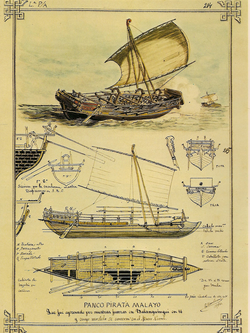

This article needs additional citations for verification. Please help improve this articlebyadding citations to reliable sources. Unsourced material may be challenged and removed.
Find sources: "Banguingui people" – news · newspapers · books · scholar · JSTOR (December 2008) (Learn how and when to remove this message) |
| Total population | |
|---|---|
| 84,000[1] | |
| Regions with significant populations | |
| Bangsamoro, Zamboanga Peninsula | |
| Languages | |
| Banguingui language, Tausug, Zamboangueño Chavacano, Cebuano, Filipino, English, Malay | |
| Religion | |
| Predominantly Islam | |
| Related ethnic groups | |
| other Sama-Bajau people, other Moros, Lumad, Visayans, other Filipino peoples, other Austronesian peoples |

Banguingui, also known as Sama BanguinguiorSamal Banguingui (alternative spellings include Bangingi’, Bangingi, Banguingui, Balanguingui, and Balangingi) is a distinct ethnolinguistic group native to Balanguingui Island but also dispersed throughout the Greater Sulu Archipelago and southern and western coastal regions of the Zamboanga PeninsulainMindanao, Philippines. They are one of the ethnic groups usually collectively known as the Sama-Bajau peoples.
The Banguingui are not officially recognized by law either in the Philippines or in the neighboring Malaysian state of Sabah.
The Banguingui language has both written and oral traditions. Its written language is in Jawi script and is fast becoming a dying tradition. Oral traditions are handed down by the kamattoahan (elders) to the kaanakanoranak baha-u (new generations).
The Banguingui built kuta (forts) throughout the Sulu Archipelago. Like their other Sama cousins, they sailed various ships like the vinta, salisipan, or bangka-bangka throughout the Sulu-Sulawesi region. At the height of the Sulu Sultanate, the Banguingui, along with the Iranun people, formed the bulk of the Sultan's navy, leading coastal raids against settlements in the northern Philippines, as well as the coasts of neighboring Borneo, Sulawesi, and the Maluku Islands. They were also heavily involved in piracy and the slave trade during the 18th and 19th centuries. The Banguingui usually sailed garay warships, in contrast to the lanong of the Iranun.[2]
|
| |||||||||||||
|---|---|---|---|---|---|---|---|---|---|---|---|---|---|
| |||||||||||||
| Lowland |
| ||||||||||||
| Highland |
| ||||||||||||
| Immigrants or expatriates |
| ||||||||||||